

 forest rights, conservation and dilemmas of growth
forest rights, conservation and dilemmas of growth
 © mazoomdaar 2011
© mazoomdaar 2011

Where forests have no trees
Of the total 60,000 claims filed under the Forest Rights Act in Assam, nearly 30,000 came from a single district. Little
wonder then that the administration controls less than one-third of Sonitpur's forests. While no political party minds
legalising this mass encroachment in the Bodo heartland, the fate of the wilderness hangs by a 2009 high court order
Jay Mazoomdaar | 22 June, 2010 | OPEN
Tene hole ki hol? Ahomoyot gutei prithibikhon tu jonghol asil (So what? At one point of time, the entire world was a forest).
It is difficult to say when one has entered a forest in Assam's Sonitpur district. The green marking on official maps is not what one sees
on the ground. Charduar reserve forest (RF) is no exception. The east-west Rangapara-Rangia railway track forms part of the southern
boundary of the reserve. But on both sides of the track, the landscape is identical.
Instead of moist deciduous forests, what makes up the horizon is a dull combination of open, empty fields, a few scattered hamlets and
patches of cropland. The residents are not apologetic about the transformation; instead, they are demanding denotification of the
forestland status since forests have long been chopped off.
The magnitude of the loss can rattle even hardened officials. Last December, within months of taking charge as the state chief
secretary, Naba Kumar Das made a visit to Sonitpur. When he reached Batashipur, the virtual disappearance of Charduar forest - more
than two-thirds of it vanished in 20 years - made him ask a few locals, admonishingly, how they felt about cutting down the last trees
in the area.
"So what?" replied a villager nonchalantly, reminding the seasoned bureaucrat that even the big city he belonged to came up by
destroying forests. "Why single us out for something that has been happening for ages? In the beginning, wasn't the entire world a
forest?"
Das and the officers accompanying him had to change the subject.
Forests have historically given way to habitations but Sonitpur could boast of some of India's best wilderness even 20 years ago. From
what is now Sonai-Rupai wildlife sanctuary (WLS) in the east to Behali RF in the west, a continuous network of tropical moist
deciduous and subtropical evergreen forests made Sonitpur one of Assam's greenest districts.
In this vast wilderness along the northern bank of the mighty Brahmhaputra, stretching till the hills of Bhutan and Arunachal Pradesh,
elephants roamed in abundance, tigers were not rare, and a host of other significant wildlife, such as pangolins, bison and wild dogs,
flourished.
Then, something went terribly wrong.
A wave of insurgency movements rocked Assam in the 1980s. The Bodos, the largest tribe living in the Assam plains, also demanded
autonomy. The movement for an independent Bodoland was formally launched in 1987 under the leadership of All Bodo Students'
Union (ABSU). The Bodo Security Force, a militant outfit, was already formed in 1986. In the mid-90s, it renamed itself as the
National Democratic Front of Bodoland (NDFB). Around the same time, another rebel outfit, Bodo Liberation Tigers Force (BLTF),
also joined the movement.
Ostensibly to stop the takeover of tribal land by Bengali settlers and the native Assamese, Bodo insurgents claimed hundreds of lives
over one-and-a-half decades till the Bodo Autonomous Council was conceived in 2003 through a pact between the state and the BLTF,
with ABSU's support. Isolated and depleted after the Indian Army struck its forest camps in Bhutan, a section of the NDFB announced
ceasefire in 2005 in favour of peace talks that is yet to take off. The anti-talks faction of the NDFB still continues with its doctrine of
guerrilla violence and extortion in strongholds of Sonitpur and Kokrajhar.
Since the beginning of insurgency in the late 1980s, the Bodo leadership encouraged its
people from all over Assam to shift to the proposed Bodoland areas to ensure a Bodo
majority. During this insurgency, many tribal and non-tribal families became victims of
ethnic clashes and some of them also moved to Sonitpur. Together, the migrants tore
down the district's forests and settled down.
Large-scale deforestation and encroachment started in 1990. In the decade that
followed, all 81 sq km of Naduar RF was wiped out. Biswanath RF suffered 70 per cent
loss of habitat and Charduar RF 60 per cent. Balipara, Sonai-Rupai and Behali were
fortunate to lose only 40, 30 and 10 per cent, respectively.
An alarmed Supreme Court did impose a ban on clear felling of trees in 1996 across the
north-east. Like most blanket orders, this ruling adversely affected livelihood in many
states, such as Meghalaya. But in Sonitpur where the ban could have safeguarded the
forests against mass felling, the administration simply did not risk implementing it.
At the same time, taking advantage of the near-total breakdown of the law and order
machinery, many Bodos and other insurgents started using their guns to make easy
money through extortion, illegal felling and poaching. Corrupt elements in the
administration found it convenient to facilitate the loot for a share of the booty.
"It was anyway very risky to take on those gun-totting militants or those who had their
support. So most officers remained silent," says a forest officer, who served in the region
in the mid-1990s, on condition of anonymity. "Some even became part of the racket. It's like 'if you anyway can't stop them, why not
join them?' Even today, there are simply too many guns in these areas."
For example, Manas national park, a biological hotspot and a world heritage site, lost all its rhinos to the insurgents. In Sonitpur, lakhs
of trees ended up at timber markets. As insurgents made the forest their safe house to dodge the security forces, the administration
was left with little access and no control.
+++
The worst is perhaps over, but peace treaties and ceasefires have
not changed too much on the ground. In Sonitpur, fear of
abduction and extortion, if not summary execution, is still very
real: real enough to keep senior officials away from the field and
make people wary to get photographed or go on record.
Satya Prakash Vashishth, divisional forest officer of Sonitpur
(east), is a rare exception. Driving through Misamari where, as
recently as in last November, Bodo militants gunned down eight
passengers after pulling them out of a bus, Vashishth would rather
discuss an Army firing range inside Sonai-Rupai WLS. "Elephants
are sensitive animals. They don't enjoy gunshots. Besides, how can
one allow firing inside a sanctuary?"
Even as insurgency bled Sonitpur, the Army and the Air Force had
to strengthen their presence in the area, anyway strategic (it's close
to the borders with China) from a security perspective. Large tracts of forestland were converted into cantonments, airbases and
camps. Facing an uphill task of flushing out the insurgents, the military here has little regard for green laws. So supply of firewood is
usually supplemented from reserved forests. But maintaining a firing range inside an elephant forest, particularly when there are
options to shift it to barren ground nearby, is surely asking for too much even in the national interest.
At an abandoned forest office (now turned into a fortified Army camp) in Kamengbari on the Arunachal border, Vashishth does not
answer why the Arunachal forest department was allowed to build an office in Assam in the first place. "It would have helped
protection of these forests had they not fled," he chuckles, adding that the fear of insurgents is usually just "in the mind". So is the
worst over? Vashishth points out that even if there has been no significant influx of migrants recently, the remaining forests are not
any safer than before.
Since selling timber has always been the primary incentive for felling trees in Sonitpur rather than clearing land for cultivation, there
is no indication that the existing encroachers will stop eyeing fresh forest tracts for extraction. But under Vashishth, the forest staff
has regained some control.
The effect is starkly visible. The narrow road leading to Kamengbari cuts through Sonai-Rupai sanctuary. Encroachers had already
cleared the southern parts of the road by the time the forest staff reasserted control. So while the northern side of the road is a
reasonable healthy forest, there is not a single tree standing in the open ground across the road.
With the first sign of weakness from the department in Sonai-Rupai, the axes will cross the road. In August 2006, when locals were
informed that the sanctuary was being brought under the wildlife division (meaning stricter protection) of the forest department, local
settlers cleared 2 sq km forest in just five days before the change in command took place.
+++
An amateur green activist, Bidhan Bora teaches botany at the
Darrang College in Tezpur. Growing up in Sonitpur, he has seen his
world change around him. As a student, Bora frequently drove to
Bhalukpong on the Arunachal border with friends for "jungle
dayouts". In those days, he recalls, the road from Tezpur to
Bhalukpong was virtually walled in by dense forests on both sides.
Once they crossed Balipara, animal encounters were frequent.
"There was not a single human settlement on either side of the
road. If we got late, evening drives used to be scary. Elephants
lorded over that road. Deer and wild boar were aplenty. Even tiger
sightings were not rare. Most animals have disappeared now with
the forests and the Army is busy widening the road for its supplies
to Arunachal," rues Bora.
The only forest Bora gets to see now is construction material for
the road - boulders and soil - being taken away in dumpers from
the adjacent buffer forests (Balipara) of the Nameri national park. A short stretch of "model road" is laid out like a smooth runway,
offering a feel of the speed vehicles will enjoy throughout. Even if the forests recover magically, the habitat will be sliced off for good.
As reminders of the past, an elephant gate stands on the road near Gamani and a few signposts mark an elephant corridor where all
one spots are hutments and sawed-off stumps of trees. "It was amazing how fast these Bodo settlements mushroomed all over Sonitpur.
Even today, they are felling trees, smuggling out timber and increasing their land holdings. A lot of benami sale of encroached land is
also going on," claims Bora.
Little wonder then that out of the 60,000 claims filed under the Forest Rights Act (FRA) in Assam, 30,000 came from Sonitpur district
alone. What is more, in the absence of any administrative scrutiny of or political opposition to Bodo rights, most of these claims are
likely to go through. In fact, this mass encroachment would have been legalized by now but for a Gauhati High Court order in October
2009.
In two petitions, 25 Bodo tribals and 17 victims of ethnic clashes sought the status of forest-dwellers under the FRA. In its order, the
HC termed both groups as encroachers, observing that "in such a situation, the [question of] recognition of their rights…does not
arise".
In January 2010, the state forest department asked its officers to
follow the HC verdict while deciding on claims under the FRA.
Most claims from Bodo encroachers resemble the conditions stated
in the petition before the HC and do not merit land titles. So
officers like Vashishth have not processed any. But a few others,
allege local conservation activists who will not be named, are
baulking under pressure and distributing pattas to "encroachers".
The Bodo leadership, however, has always denied the encroacher
tag. Urkhao Gwra Brahma, former president of the ABSU and
former Rajya Sabha member, repeatedly attacked the state for not
allowing "creation of new forest villages after 1980" to
accommodate displaced Bodo people, claiming that land where
Bodo migrants settled down was already degraded due to wanton
felling by timber mafia in collusion with corrupt forest officials.
The Bodo leadership also warned against giving land to "other
forest dwellers" as that would amount to "loss of tribal land".
Most non-tribal forest villages in the district were established much earlier than the Bodo settlements. But even the earliest non-tribal
settlers, who had carved out their forest villages in the 1950s, do not meet the FRA eligibility clause that requires non-tribals to stay in
the forest for 75 years prior to 2005. A denial of land rights, either on technical grounds or due to Bodo opposition, may drive the non-
tribal population into a fresh ethnic conflict here.
"Bodos never had any dependency on forests whatsoever. They are only interested in chopping down trees and grabbing land. But they
are taking advantage of the FRA. For tribals, the Act fixed the cut-off year (for showing land occupation) at 2005. If it (the cut-off)
were fixed at 1980 as originally proposed, most of these encroachers would not qualify," protests Bora, claiming that no other place in
India has suffered such loss of forest cover in such a short period of time.
+++
Bora might be right. The astounding scale and rate of deforestation
apart, what is shocking is the fact that such rampant felling is not
so much to free land for shelter or agriculture as it is to simply
monetise timber.
Between 1991 and 2001, in the entire north bank landscape (north
of the Bramhaputra river) of Assam and Arunachal Pradesh, loss of
forest cover was just 2.38 per cent. But in the Sonitpur elephant
reserve area, it was a staggering 24.48 per cent. Surprisingly, both
areas have recorded a similar growth (about 8.60 per cent) of
agricultural land in that period. Clearly, 24.48 per cent forest was
not destroyed to make way for agriculture. It was just cut up and
sold off. A comparison of the growth of degraded forests (result of
heavy felling) in the two areas clinches the case: just 1.56 per cent
in the entire landscape and 21.29 per cent in the Sonitpur reserve.
On paper, Sonai-Rupai RF (a sanctuary since 1998) covers 220 sq
km. By 2001, it lost 7 per cent of its forests. After mass felling over the next five years, only 128 sq km (58%) of the sanctuary remains
forested. The story is the same in Balipara RF (190 sq km). It lost 27.59 per cent of forest cover but corresponding growth in cropland
was just 11.97 per cent.
In 1991, 18.44 per cent of the Sonitpur district was forested, including 1.58 per cent of degraded forest. In 2001, it still had 18.22 per
cent forests but out of it 7.60 per cent was degraded. Clearly, the district lost more than one-third (37 per cent) of its quality forest in
just 10 years. In actual terms, one study puts the overall forest loss in Sonitpur at 232 sq km between 1994 and 2001.
The enactment of the FRA in 2006 clearly emboldened the encroachers. On one hand, they claimed legal ownership of "tribal land"
they had already cleared. On the other, they started extending land holdings by felling more trees. The biggest mass encroachment was
attempted at Behali in March 2009 when hundreds of trees were chopped off.
Not that the forest department did not try to hold onto its ground. In 1993, five persons were killed when forest personnel opened fire
after being attacked by encroachers. Then, between 1994 and 2002, the department carried out 33 anti-encroachment drives,
demolished 4117 huts, arrested 49 encroachers and reclaimed 7.39 sq km. In recent years, Vashishth himself has foiled several
attempts at encroachment in a persisting battle of nerves.
But, evidently, that has not been enough.
+++++++
Adding to encroachment and the deadly encounters of security
forces and insurgents, the forest department has yet another
conflict to deal with. Rapid loss of tree cover has unsettled the
largest inhabitants of Sonitpur's forests. If human settlements on
their traditional migratory routes were not enough, disappearance
of forests where they foraged pushed the hungry elephants to raid
croplands.
The raging conflict has partially subsided since a WWF-India team
started work here in 2003, the year that recorded 32 elephant and
20 human casualties. Since then, retaliatory killings by poisoning
have become rare. But the space crunch makes frequent face-offs
inevitable. Between 2007 and 2009, conflict claimed 8 elephants
and 20 people.
Vashishth has just finished debriefing his field staff on the
whereabouts of a huge tusker that often intimidates even the
soldiers stationed at nearby Lama camp. For the first time, he looks
despondent: "There is little hope for the elephants here. Big animals need more space. On paper, we have large swathes of forests. But
not even one-third of it is intact."
In official records, Sonitpur district has more than 1200 sq km of forestland. But what is standing on ground and under the
department's control accounts for less than 400 sq km -- 200 sq km of Nameri NP, 128 sq km of Sonai-Rupai WLS and about 60 sq km
of Behali RF. The rest is either degraded or has just disappeared.
At an average actual holding of 2 hectares per family (though the FRA allows a maximum of 4 hectares), Sonitpur's 30,000 claims
require around 600 sq km of forestland. Custodian of the bulk (328 sq km in Nameri NP and Sonai-Rupai WLS) of the surviving
forests, Vashishth knows he is fighting a losing battle in the district and, sooner or later, all these claims will be granted under the
FRA. Tired of a long vigil and ready to move on, he offers a "compromise solution".
"Always hungry for timber, the encroachers have cleared far more forestland than they actually occupy or have filed claims for. All
these tiny settlements are scattered across the forest landscape. If they are given titles for equivalent land (total 600 sq km) in clusters
rather than all over the place, we can still carve out a couple of hundred sq km to regenerate the forest. The stumps and the rootstocks
are all still there," he says wistfully.
Given the political compulsions in this insurgency-ridden district, regenerating hope, let alone forests, seems like a very tall order.
Mazoomdaar is an independent journalist






 Home | Reports | Related Articles | Resources | Gallery | Feedback | Contact | About
Home | Reports | Related Articles | Resources | Gallery | Feedback | Contact | About
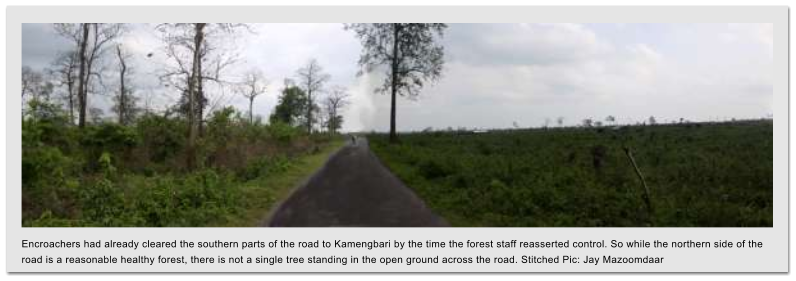
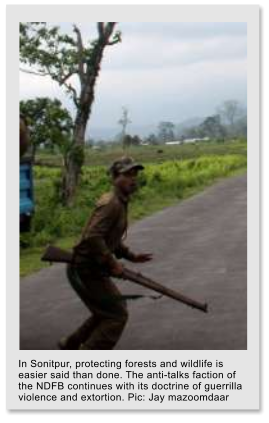
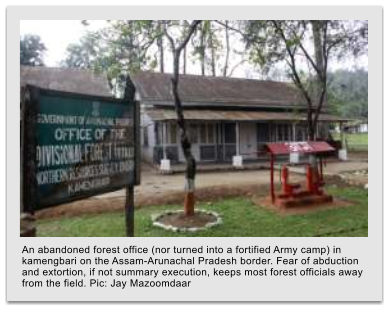

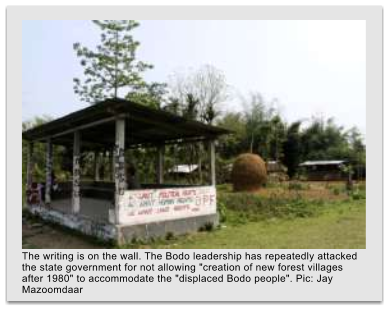
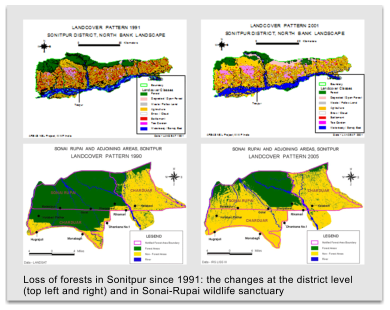














 Home | Reports | Related Articles | Resources | Gallery | Feedback | Contact | About
Home | Reports | Related Articles | Resources | Gallery | Feedback | Contact | About





















